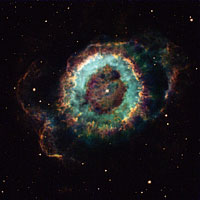

Birth and
All stars are formed from Nebulae. Nebulae are clouds of dust or gas. The gas is mostly hydrogen with a little helium . The gas fills most of the volume of the cloud, but the dust makes it opaque. These clouds are the birth place of the star.
The formation of a star begins with a collapse. This collapse is triggered by a shock wave. The gravitational force now contracts the nebulae and this is the first stage of the star formation. After about 10 million years, the core gets hot and if enough material is present the temperature reaches 10 million degree C and a nuclear fusion reaction starts. With this fusion reaction, lot of energy is released. This energy then heats up the star and stops the collapse. Now the star is stable. An example of a stable star is the sun, considered at its mid life.
When all the hydrogen is exhausted due to the fusion reaction the star dies. The hotter and brighter a star, the faster it dies. Which means the fusion reaction is faster and has exhausted all the hydrogen. Once the star dies, it becomes a black dwarf, or black hole. Our sun is going to live 10 billion years. A star that is 20 times bigger than the sun will only live 10 million years.

Answer - Uranus rings go up and down (and not side to side as most rings of other planets). This is due to the weird tilt of Uranus (98 degrees). There are 11 dark rings around Uranus which were formed from broken up space objects creating dust rings. The small moons around Uranus help the rings stay together through the gravitational effects. The weird tilt of Uranus is due to a planetary collision which probably created a lot of dust that could not escape the gravity. This dust formed the rings.
Question - Why I chose the question? How is it relevant to the future?
Answer - I chose this question as I was interested in this topic and I didn’t know anything about it. Stars forming and then dying seemed interesting and I wanted to investigate it. I looked at the rings of Uranus on the internet and I wanted to know why they were formed.
This is relevant to me as it helps me understand the world. It shows me the vastness of the universe. I learnt that the speed of light is 186,000 miles per second and the distance between the earth and the sun is 93 million miles. It thus takes 8.3 minutes for a light ray from the sun to hit earth. And the sun is the closest star to earth. There are lot more other suns in the universe. We have a lot of the universe that we have not covered yet. The world is huge.
It also shows me that even the largest things die.


No comments:
Post a Comment